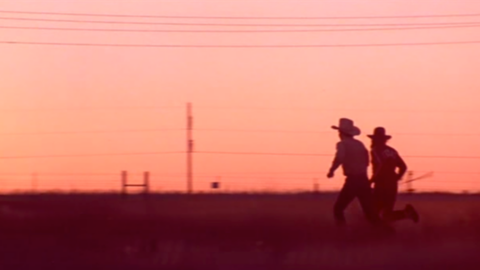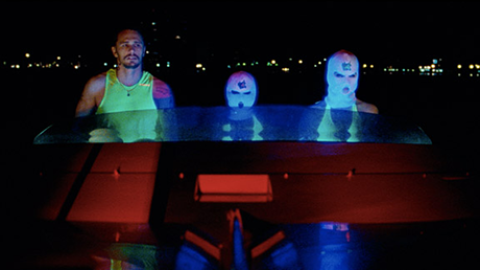Interview: Harmony Korine
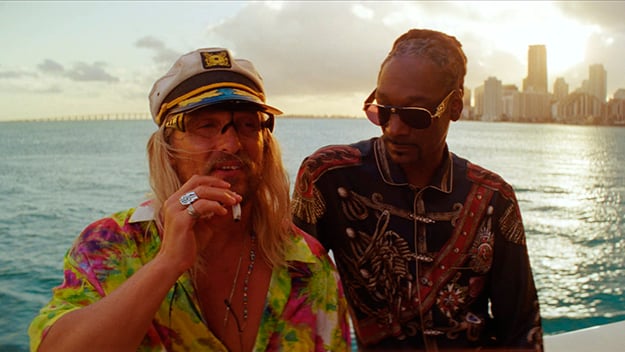
Wild at heart, grotesquely beautiful, always poetic, Harmony Korine’s tales of the margins often come with unexpected pockets of wisdom. So it is with The Beach Bum, his new, candy-colored version of a ’70s stoner film, set, like Spring Breakers, in a Southern Florida that feels very much like the edge of the world. From his native Tennessee (the backdrop of several of his previous films), Korine moved to the area a couple of years ago, like several pop art painters. These days a painter himself—the Centre Pompidou in Paris gave him a big career retrospective last year, and in New York he is represented by Larry Gagosian—Korine has infused his last two films with the place’s unique light, tropical vibe, and chromatic exuberance. Teetering on the abyss—joyfully debauched here, where Spring Breakers was dark and menacing—is Moondog (Matthew McConaughey) a one-book-only poetic genius whose days are spent floating in a beatific haze of pot, alcohol, and sex. Sunburned, bleach-haired, and often dressed as a woman, Moondog is prone to accidents, like an old-fashioned silent movie star. But even car crashes, jail, death, his daughter’s ruined wedding, and a shark attack are all met with a smile. Isla Fisher, Zac Ephron, Snoop Dogg, and Jimmy Buffett also star.
Film Comment spoke with Korine in advance of The Beach Bum’s world premiere on March 9 at South by Southwest.
Congratulations on the film! I love it.
Thank you so much. That makes me very happy.
Well, it’s a happy film, it’s so refreshing.
I was trying to make a happy film.
Place has always been very important in your work—the sense of place. What is it that you like about Miami, and the world that you set the film in?
I don’t know, it’s strange, I can’t really put my finger on it. I lived here for a couple of years. I’ve really been infatuated with the kind of strangeness, the beauty, the palm trees, the sky, the… vibrations of South Florida—Miami, Key West.
You talked about Spring Breakers as “liquid cinema,” and The Beach Bum has a similar visual scheme, the colors, the fluidity, cinematographer Benoît Debie. But Spring Breakers had this incredibly destructive beauty. It was like a beautiful hell. Here even disruption is benevolent.
Yeah, Spring Breakers was a movie that had this ominous tone to it. We talked about a liquid narrative, and elliptical, almost like it was meant to be a pop poem or something. With this movie I wanted to make something that still had a similar structure but was more of a comedy. I felt like I wanted to laugh, and make something with the characters celebrating life in their own way. And I liked the idea of making a stoner comedy. As a kid I grew up on Cheech and Chong. I miss that. I wanted the film to feel a little bit like it was guided by weed smoke. And it has a slightly hallucinatory vibe to it. But it has totally different characters and storyline—it’s almost completely the flipside of Spring Breakers. There is no real menace in The Beach Bum. It’s based in the idea of a cosmic America, a lost Key West. The idea of getting wasted is a virtue to Moondog, living in the moment, finding the folly and humor in it all, getting stoned and checking out of reality, being happy. Spring Breakers was more menace and the darkness of the American dream.
Was there an image, a person, or a poem that gave you Moondog?
I spend a lot of time in the Keys. Sometimes I just jump in my car, leave Miami, and drive down to the Keys. I love the idea of living in the southernmost point of the United States, a forgotten place. It is kind of its own world. There’s like a celebration and a lack of ambition. It’s like a check-out culture—where people check out. People go there to mostly just disappear and enjoy the sunset. So a lot of it was just spending time there, hanging out with people. And then I started seeing a lot of characters like Moondog, with the houseboat, fishermen. I just put them all together. It’s kind of an amalgamation of classic stoner Key West archetypes.
His age is so different from what you normally work with. With the exception of Trash Humpers, your work usually gravitated toward younger generations.
Yeah, I always loved youth culture, and making films about that. With this I just felt different. I like the idea of a character who was in middle age and maybe possessed by some kind of strange gift. But it’s a comedy, it’s not about a tortured genius—it’s about someone who doesn’t even really care about it. That gift is almost an appendage for him, and it blends with his life. It felt like I was trying to make a film about someone in that world.
Which is an interesting statement about art and creation, no?
Definitely. And where does the gift come from? People get it from all kinds of places. Where does the creativity exist? His creativity exists in a kind of sensualism, a dysfunction—in an extreme lack of filter, and also in a desire to live completely in the moment, regardless of where he is socially or economically. He could have everything and he can have nothing. And he is still trying to make it happen, trying to make himself laugh.
Speaking of economics, unlike most of your other films, The Beach Bum is set, at least in part, in a world of extreme wealth. Does that kind of environment fascinate you?
It all fascinates me. The extremes on both sides. It’s interesting the way people deal with it. The way things look and how they maneuver. Like the Minnie character, Moondog’s wife [played by Isla Fisher]: she has all this money she’s inherited, and in some way, she is just as wild as Moondog is. She has a similar irreverence towards money
Minnie keeps coming back in the film, even after she exits the plot. It brings a romantic ballad quality to the piece. Was it always intended as a love story or did it come in the edit?
No, I wrote it that way. I wanted there to be a love story, even though she is in only a specific portion of the film. Even in the last half of the movie, in a sense, it is her love that drives them. He’s trying to make her proud or prove her wrong. Even though they’re unfaithful to each other, and their marriage to a certain extent seems hopeless, you see that when they’re together they complete each other.
Why Matthew McConaughey?
I am a fan of his. Also, there is this persona that already exists about him, it’s part of the pop consciousness. I thought it was fun. A lot of people think that Matthew is so close to the Moondog character in real life! Which isn’t actually true. I like the idea that there’s the public persona that exists and that we’re playing with. Trying to push it into something that is hyper-comedic.
I was thinking about his performance, the way he moves his body, even the way you frame him. It made me think of your love for Buster Keaton and the silent comedians.
Definitely. I encourage physical humor. I always loved the Marx Brothers, the Three Stooges, and Buster Keaton. So the physicality was definitely important. And then with Matthew as Moondog, I felt like he already knew this kind of character—the way he and I talked about him was very much about the physical dimension. Also, Moondog is always stoned in one way or another. There is never a moment when he’s not buzzed. So he had to be in this perpetual state of almost falling down.
Which really lends itself to the tropes of silent comedy—the runs, the falling, the water.
That’s my favorite.
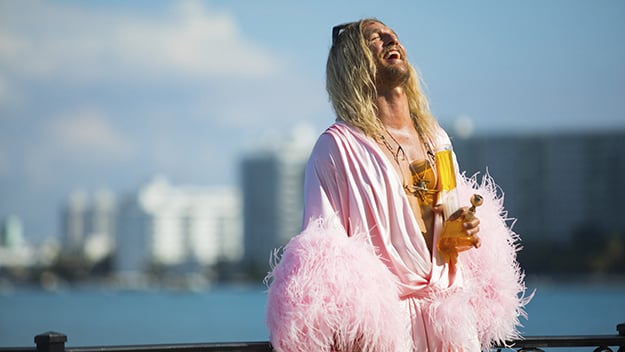
I particularly enjoyed this sort of debauched hedonism that the film has. It seems to run against the grain of our present culture.
It wasn’t trying to be, but who knows. I think Moondog’s someone who exists in his own world. He has his own pleasure system. He’s always trying to get high, to feel good, to make something of the moment. I don’t think he has any type of filter or even knows anything about politics… He’s really a character who has this inner music he’s following. And the classic stoner thing: if something feels good or tastes good, then you’ll go after it.
Still, he is a poet and in the film, you quote some famous poets and writers: Walt Whitman, Richard Brautigan, D. H. Lawrence. Words in the film are important, so to speak—they’re not just tossed around.
Yeah, I was thinking a lot about Richard Brautigan when I was writing this. What if Richard Brautigan lived in Key West? I was born in Bolinas, California. My mom used to clean Richard’s house when he lived there. I used to hear stories… I found it fascinating, also because I love his writing. So I could introduce just another subtle layer, that I have this connection with Brautigan. The other poems I thought were writings that affected Moondog, either directly or indirectly. Things that he wouldn’t even necessarily acknowledge, but they were poems or writers that maybe he had been influenced by subconsciously.
When you work on something like this, which seems so free-form to the viewer, is it all that scripted or do you kind of adjust?
It’s interesting with this. It’s mostly scripted. In some of the other films I pushed the improvisation more. With this, there were scenes where Matthew would riff on some ideas. But it’s mostly scripted. Probably the most scripted of all my movies. Also because a lot of it is about the jokes and the humor.
There is also a lot of verbal comedy you normally don’t have.
Yeah. All the actors worked harder to make it seem like it was just stone-blotched.
Can you talk a little bit about the visual structure of the film and your collaboration with Benoît Debie, in both films?
It just worked out with Benoît. He is a master of color and diffusion—he thinks like a painter, he makes the mood and vibe clear. There are some colors, mostly primary colors, that I really love, in painting and in film. I try to use these colors as much as possible, and variations of certain colors. And so much of the film is about the way it looks and feels, the world that he lives in. I wanted to create something where the location was like a character. So you [the viewer] can imagine being there: the house, the rocks, the incense that they are burning. I was hoping that even if you weren’t there, you could feel like you were there and you could smell it.
It definitely has the potential of a film in “Smellorama.”
Yeah, we wanted to project it in a couple of theaters with weed smoke. I don’t know if they will be able do it. But maybe there is some way we can pump the smell of weed and incense into theaters.
This is a higher budget than you’ve ever worked with before. Is it helpful, or not, to work with more money?
It was still relatively small, but more than my other films. It’s always a challenge. It never really feels like I have… In advertising, when you have more money, it feels like you have more time. But with this, the movie, the ideas, the visuals, are ambitious. There were over 300 locations, and it goes by very quickly. So just making the days was hard. There are always challenges. It never felt particularly cushy.
You shot on 35mm again, like Spring Breakers. Why film?
Yes, I shot in 35mm. The soft edges, the grain structure, the romance, the way it absorbs color and shadow—you can’t compare it to anything else. And I hope it can be seen that way somewhere. I’m going to make a print for myself. I don’t know how many theaters can project it anymore. So it’s a challenge, but I’m definitely going to be making a couple of prints.
After Cliff Martinez and Gucci Mane in Spring Breakers, here you used Jimmy Buffett and Snoop Dogg. That is a big shift.
Exactly. I’ve always been a fan of both. They’re both iconic stoners. And Jimmy Buffett’s music and the mythology around him is all over the film. I almost saw it as a more debauched Jimmy Buffett song. So I wanted to include them. I thought it would be nice to have both of them in the film, because they both represent the culture.
Why do you make films so rarely?
Because I’m just really slow. When I was young, I thought I would be really fast. Sometimes I think about it: “Why am I so slow?” But it just takes me a while. Like, I never really understood directors who have five or six movies planned out ahead, because it confuses me that I never really know what I like next until one movie is done. Then it takes me a while to figure out what’s interesting, or to feel any type of connection to the culture in any way. And I do other things: I mostly paint right now, and make artwork. I think this is only my sixth movie.
Do you wish you were working more?
I do sometimes. But it’s hard, because the process is difficult. Especially when you’re writing the script itself. It’s hard when you have a family, because for me it takes a lot of time away from them. It’s a couple of years where, even if I’m mostly there, my mind is thinking about film.
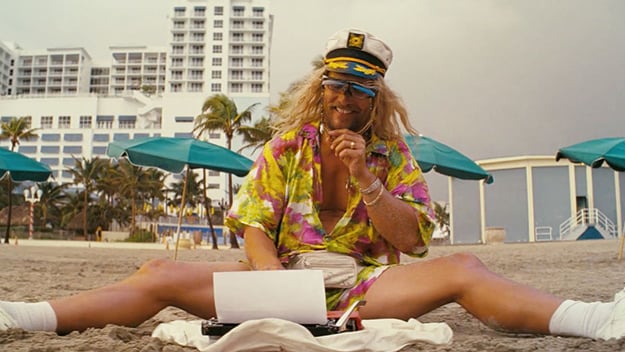
How would you describe the relationship between your paintings and your films? Do they exist in parallel worlds or is there an exchange?
I don’t know, it’s hard to say. I would say that they affect each other, but they’re also very different. Painting is much more solitary, and not necessarily storytelling—it has to deal with the image in front, and making marks, colors, and gestures. In film, it’s so story-based and so collaborative: you always have to explain it to people. Whereas when you make art, it can just exist on its own because it exists. So I’m sure that because they both they come from me, there is a kind of dance. But I’m not sure if they parallel directly.
Now it seems that the paintings have taken a different course.
Yeah, that’s probably right.
This interview originated with wanting to make something on your influences in general. What has been key in your making films?
My dad made documentaries. Watching him making films when I was really young, that was probably something. He made documentaries for PBS about the South. Sort of obscure Southern musicians, carnivals, and moonshiners—real characters. And as a kid, my parents would take me to the movies a lot. It was almost like a form of their communicating to me. So I would see grownup movies as a kid. I just loved movies and images, and I wasn’t really good at anything else. It seemed natural, something that I wanted to do. The other thing would be skateboarding or hanging out on the street: it mostly made me free.
Do you still make shorts? Do you still go out with a camera and shoot things by yourself?
Every once in a while I’ll do stuff. I have things that I never put out. I have a pretty good archive of things that one day I’ll start to slowly put out there.
I remember many years ago, I saw something you did that was supposed to be a trilogy, with Gus Van Sant. It never came out.
Yeah, that never came out. That was a film I wrote called Jokes. And there were three, it was like a triptych, and each of them was based on a joke. The idea of a joke—like, guy walks into the bar with a parrot on his shoulder—and then I would write a story about the joke, extending the punch line. So I turned them into stories. I just made up stories around jokes, essentially. Then Gus directed one called Easter with the albinos. We showed it last year at Centre Pompidou.
You often say you like Clint Eastwood. Did you see The Mule? Strangely enough it made me think about The Beach Bum.
No, I haven’t seen it. But I want to. I love Clint Eastwood. He’s always been my favorite director. Every Which Way But Loose is my favorite of his films. Also Pale Rider. He’s the American id.
Do you have a new project?
No, I’m just thinking that it was so fun making a comedy. I would like to make a film about the Captain Wack character in The Beach Bum [played by Martin Lawrence]. I would love to write a whole film about a guy who’s the world’s worst dolphin tour guide. Someone that thinks that all sharks are dolphins.
Giulia D’Agnolo Vallan is a New York–based film writer and curator, and U.S. programmer and selection committee member of the Venice Film Festival.



